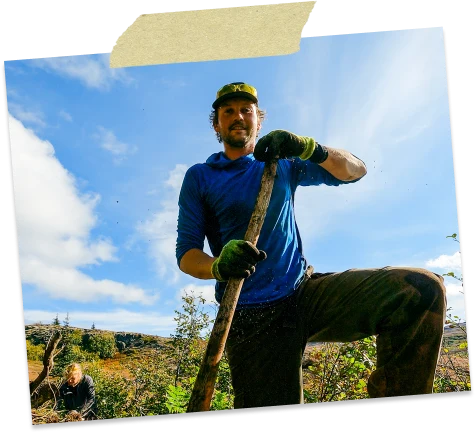Denali State Park ~ April 2018
Stuart Leidner, Mat-Su Trails and Parks Foundation Executive Director

I get excited seeing our partners’ new projects. Their projects ensure that you and I get to experience some remarkable places here in Alaska. So when I saw a grant request from the Friends of State Parks, Mat-Su for equipment that would support a larger initiative by Alaska State Parks for a new 15.5-mile snowmachine route between the Kesugi Ken Campground and Byers Lake Campground, I wanted to get out on the ground with them to see their vision.
Most people typically experience a trail once it has been established. A trail may lead to an amazing view, a resting spot, to some interesting geologic features, or wind through the woods; in any case, someone had to work out a safe, sustainable route that everyone can travel and enjoy. I wanted to see that process in action.

And so it was that I found myself early on a Friday morning in late April driving up to meet with Chris Love from Denali State Park to get a behind-the-scenes view of establishing this new winter route. Heading north left no doubt that winter hadn’t quite loosened its grip, and I hoped there would be a good solid crust to support my snowshoes.
I was heading out today with Ranger Chris Love, Park Specialist Justin Dipaola-Allen, and Natural Resource Technician Carter Forney. It was spitting snow and rain as I rolled into the park, so I gathered up my gear for what might be a wet trek through the woods. I had been to the Kesugi ranger station a few times and, as always, I marveled at what a fantastic jewel this is for the state. I was warmly welcomed by Chris and our team got ready to head out.
Before we got going, I learned some about the history and objectives of the project. Chris, Justin, and Carter all started with State Parks about eight years ago. They know each other’s idiosyncrasies, passions, and function really well as a team. Their enthusiasm was contagious; I could feel the excitement these guys have for their work. More importantly, their combined twenty-four years of experience in the park will shape the trail and an influence how people enjoy it. There are so many variables that go into a good trail design, but a quality user experience starts with a good route. When they first envisioned this project, they spent a considerable amount of time looking over maps and viewing 3D projections of the topography to identify terrain features that increased people’s enjoyment or were going to prove challenging during construction. If you are familiar with the area, you can probably name three or four obvious ones right off the top of your head. Creek drainages are an example of features that need careful consideration in route finding. These choke points will require some significant trail crew hours to create a solid trail tread, minimize the impacts on soils, and protect the stream.

Since this is a winter route designed for snowmachine travel, there are physical factors that need to be taken into account for this new trail. Where can we put a trail that is 14 feet wide and disturbs as few trees as possible? As we scouted, we talked about trees to save and those that were either dead or dying that could be good candidates for removal. The removal of trees infested by spruce bark beetle is an added benefit. As I watched Chris and the crew, they focused not just on the user experience, but also took into account the trail grooming equipment capabilities when calculating slope angles and approaches. According to Love, “We want to ensure that we incorporate wide enough turn radiuses for the grooming equipment, as we don’t want to get in a pinch point that gets the machinery bogged down.”
That 50,000-foot view then gets narrowed down to a “roughed in” trail route. This is where my day begins with them. Luckily, it was early in the season and I only trailed behind a bit as they galloped across the snow. I don’t think I want to try to keep their pace once they have weeks of trail work under their belts. We were at the first of many choke points, Troublesome Creek. Laying out and building the trail to traverse up the creek banks here and at Byers Creek will absorb a lot of manpower this summer. With inclinometers in hand, Justin and Carter dashed over the top of the bench to look for the best possible route for the trail.

This phase, Chris explained, is still at the “10,000-foot level.” The pink and orange flagging that we are tying every 50 feet or so roughs in the route. Once the snow has mostly disappeared, they will return to refine the route with more detailed route notes. This information guides the trail crew that will come in later to clear brush and trees. That is when the real work begins.
If you have ever worked on a trail crew or come across them in the backcountry, you know they are an uncommon bunch. They are hard core. “Being in the backcountry is their passion. They get antsy being in the front country with all the creature comforts,” quipped Justin as we talked about the crews he has worked with at Denali State Park. I take him at his word. Suffice it to say, once they get their teeth into a project, they are committed until the season is over, the snow flies, and it is time to focus their energy elsewhere.
Justin and Carter have honed their trail knowledge and skills over the last eight years. They joked that when they first started there was certainly some trial and error. “We ended up having to fix our mistakes, you learn quickly that way,” Carter said with a smile. They participated in trainings and were mentored by more-seasoned crew hands. Now they lead those crews and mentor the next generation that will build the trails we all get to enjoy.

In this area of the park, this trail will provide motorized access in winter along a corridor where riders can access the public use cabins at the two campgrounds and reach more terrain below Curry Ridge. There are long rollers and picnic-perfect spots to pull over and enjoy the views. While primarily designed and created for motorized access, I think other winter trail users will find this to be a great opportunity to explore as well.
I know I look at trails through a different lens when I am out there and think about all the work that went into getting the route established. Should I come across a trail crew this summer (which I am bound to do a few times) I will stop, thank them, admire their work, and maybe bring them some high-protein snacks to share. Here’s to the summer ahead…hope to see you out on the trails!
Photo Credits: Carter Forney (top), and Stuart Leidner

EASIEST WAY TO DONATE For Alaskans
While applying for their PFD online, Alaskans can choose to Pick.Click.Give. in increments of $25. All donations are tax deductible and donors will receive tax documentation from the State once their donations have been processed. Permanent Fund Dividend applications are available from January 1 to March 31, though Alaskans may choose to add or adjust their pledges online through August 31.
Apply for Funding
Grants and Event Sponsorships
The Mat-Su Trails & Parks Foundation partners with organizations and local governments on projects and efforts that expand and enhance the valley’s network of trails and parks. Find out how we can help fund your next trail, park, or recreation project!
